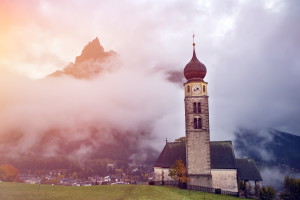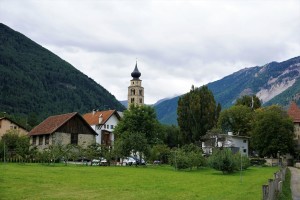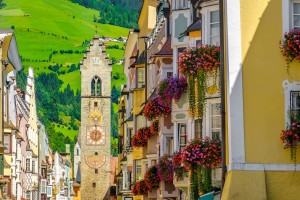
©Bigstock.com/melis
Compared to other areas of the country, the Trentino-Alto Adige/Südtirol region enjoys an extensive level of autonomy that was transferred to its two provinces during the 1970s. They possess various self-governing rights, not least due to their strong regional culture. These rights derive from the protection of the Ladin and German population groups. As such, certainly in part due to historic reasons, about 70% of the population of the Autonomous Province of Bolzano speaks German. This peculiarity manifests itself in many multilingual place names, but also in the local alpine flair that can most certainly be found in the five most beautiful places in the Autonomous Province of Bolzano as part of the private association “I borghi più belli d’Italia.”
Kastelruth
One of the province’s southernmost places is also among the most popular tourist destinations of Trentino. The predominantly German and Ladin Kastelruth or Castelrotto (approx. 6,800 inhabitants) is located at the Seiser Alm (Alpe di Siusi), Europe’s biggest high alp. Enormous winter sport areas and a surplus of hiking routes lead you to dizzying heights.
Beyond its virtually magnetic scenery, Kastelruth’s affiliation with the most beautiful places in Italy stems from the magnificent architecture with an inviting town centre. The massive neoclassical, onion-domed belltower of the parish church Sankt Peter und Paul (Santi Pietro e Paolo) has become something of Kastelruth’s landmark. You should also visit the Cavalry with its small chapels – way more than just a pilgrimage destination.
Klausen
First settlements on Mount Säben high above Klausen or Chiusa (approx. 5,200 inhabitants) date back to pre-Christian times. The historic town centre might be “newer” in comparison yet is just as fascinating. The many oriels, façades, crests and frescoes display a plurality of stylistic movements bridging the gap between the Gothic and the Renaissance period. Likely newly built during the second half of the 15th century and renovated several times in later periods, the imposing parish church Sankt Andreas (Sant’Andrea) is home to numerous paintings and figurines with a Gothic touch. Discover even more hints of Gothic inside the Apostelkirche (Chiesa degli Apostoli).
Find one of the oldest Christian pilgrimage sites on the Säben, home to an early Christian church as early as the beginning of the 5th century. The actual Säben Abbey, however, was built much later and became a Benedictine abbey in 1686. It was only dissolved in November 2021 due to lack of new incoming nuns. The church been debating the future use of the abbey ever since. The grand complex on the ruins of an episcopal medieval castle, expanded around 1890, is absolutely worth seeing.
Glurns

©Bigstock.com/pisces2386
Also known as Glorenza, this municipality in Western Trentino with a population of just above 900 is situated in the Vinschgau on the upper river Adige. This small place is probably best known for its still fully intact town walls dividing Glurns into an inner and an outer town. It was only built during the 15th century under Emperor Maximilian I and used to incorporate both the then-village Glurns as well as the former town of Duke Meinhard II. Its central axis, today’s Laubengasse, still shows ruins of Meinhard’s former medieval fortification structure.
Let the hustle and bustle of the town pass you by while relaxing on Glurns’ main square with its drinking water fountain and the two cool chestnut trees. However, it does get very busy here during festivities and on market days. Find the parish church Sankt Pankratius (San Pancrazio) with its various frescoes and a unique sandstone relief outside the town walls. The town gates and the bridge across the Adige are just as fascinating.
Neumarkt
Bishop Conrad II of Trento had today’s Neumarkt or Egna (approx. 5,400 inhabitants) founded as a market settlement along major trade routes. The medieval village quickly gained significance and became very wealthy, something that’s reflected in the townscape created mostly during the 16th century. Many buildings and courtyards will surprise you with their Venetian style creating an exciting contrast to the diverse nature of the Alto Adige Wine Road and the stunning Trudner Horn Nature Park in the southernmost part of the province.
Neumarkt’s two main churches stand tall. Resting on Romanesque foundation walls, the parish church Sankt Nikolaus (San Nicolò Vescovo) sticks out due to its fascinating stellar vault. The late Gothic church Unsere Liebe Frau in der Vill (Santa Maria in Villa) emanates particular elegance. Endowed by the Würth company in 1992 and providing enticing architectural highlights, the Equus fountain in the industrial area shows off a far more modern side. The pilgrimage hospice Klösterle is among the few almost completely preserved of its kind. Pilgrims to Rome stayed in this Romanesque structure far into the 16th century.
Sterzing
Finally, we head for Sterzing (approx. 6,900 inhabitants), also known as Vipiteno, in the north of the autonomous province. It is one of Trentino’s tourism hotspots due to its wide variety of sport and leisure options, culture, and shopping possibilities. Find several recreational areas, such as the awe-inspiring Monte Cavallo and the Funivia Racines-Giovo, with plenty of hiking trails in summer and ski slopes in winter in close proximity.

©Bigstock.com/Luca Lorenzelli
It’s not (just) its stunning nature that makes Sterzing one of the most beautiful places in the Autonomous Province of Bolzano as the townscape is most certainly worth checking out as well. The modern town theatre with Sterzing’s library feels modern yet fits effortlessly into the scenery. In contrast, the late Gothic hall church Unsere liebe Frau im Moos (Chiesa di Nostra Signora della Palude) goes for a decisively more commanding presentation with the vault as its highlight. The town hall includes a rustic late Gothic parlour and the charming baroque Deutschhaus (Antica Commenda dell’Ordine Teutonico) houses inviting museums.
The Autonomous Province of Bolzano has numerous stunning spots in store beyond its exceedingly arty capital with plenty of churches. The magnificent, diverse scenery with tall mountains and cool valleys ultimately serves as a wonderful backdrop for picturesque places with fascinating history and many a thrilling sight. Plenty of churches, several surprises and lots of natural beauty accompany the most beautiful places in the Autonomous Province of Bolzano – the perfect ingredients for a somewhat different holiday in Northern Italy.